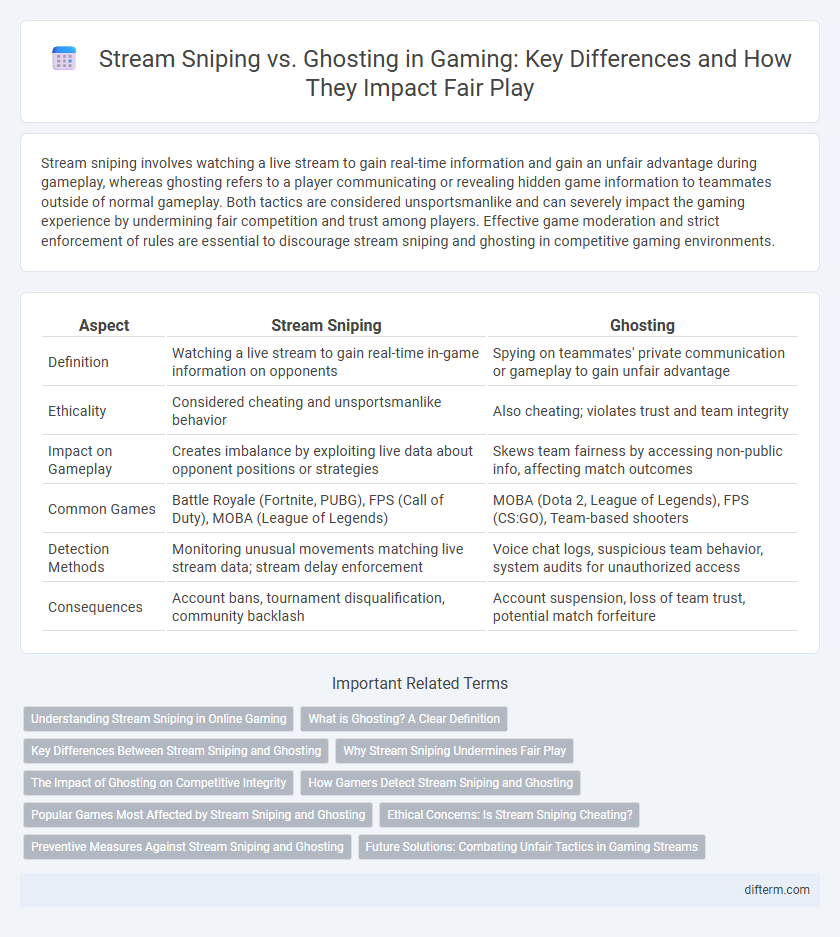Stream sniping involves watching a live stream to gain real-time information and gain an unfair advantage during gameplay, whereas ghosting refers to a player communicating or revealing hidden game information to teammates outside of normal gameplay. Both tactics are considered unsportsmanlike and can severely impact the gaming experience by undermining fair competition and trust among players. Effective game moderation and strict enforcement of rules are essential to discourage stream sniping and ghosting in competitive gaming environments.
Table of Comparison
| Aspect | Stream Sniping | Ghosting |
|---|---|---|
| Definition | Watching a live stream to gain real-time in-game information on opponents | Spying on teammates' private communication or gameplay to gain unfair advantage |
| Ethicality | Considered cheating and unsportsmanlike behavior | Also cheating; violates trust and team integrity |
| Impact on Gameplay | Creates imbalance by exploiting live data about opponent positions or strategies | Skews team fairness by accessing non-public info, affecting match outcomes |
| Common Games | Battle Royale (Fortnite, PUBG), FPS (Call of Duty), MOBA (League of Legends) | MOBA (Dota 2, League of Legends), FPS (CS:GO), Team-based shooters |
| Detection Methods | Monitoring unusual movements matching live stream data; stream delay enforcement | Voice chat logs, suspicious team behavior, system audits for unauthorized access |
| Consequences | Account bans, tournament disqualification, community backlash | Account suspension, loss of team trust, potential match forfeiture |
Understanding Stream Sniping in Online Gaming
Stream sniping in online gaming involves players watching a live stream of an opponent's gameplay in real-time to gain an unfair advantage. This practice disrupts competitive balance by allowing stream snipers to anticipate strategies, locations, and movements, severely impacting the integrity of matches. Many game developers implement strict penalties and use advanced detection tools to combat stream sniping and protect fair play.
What is Ghosting? A Clear Definition
Ghosting in gaming refers to the act of gaining unauthorized information about opponents' locations or strategies through watching a live stream or replay without their knowledge. This practice gives players an unfair competitive advantage by exploiting real-time insights to anticipate enemy movements or tactics. Unlike stream sniping, which directly targets active streamers, ghosting can occur more subtly, often through shared resources or delayed footage.
Key Differences Between Stream Sniping and Ghosting
Stream sniping involves deliberately watching a live stream to gain an unfair advantage by tracking the streamer's location and strategies in real-time, compromising competitive integrity. Ghosting occurs when a teammate provides covert information from outside the game, such as live communication or data sharing, influencing gameplay without direct observation of the opponent's stream. The key difference lies in stream sniping's external, viewer-based advantage versus ghosting's internal, team-assisted information exchange.
Why Stream Sniping Undermines Fair Play
Stream sniping compromises fair play by exploiting real-time information from live broadcasts to gain an unfair advantage, disrupting the natural competition dynamic in games. This behavior skews match outcomes, negatively impacting the experience for players who rely on skill and strategy rather than insider knowledge. Game developers and communities emphasize transparency and fairness to maintain balanced gameplay and discourage such unsportsmanlike conduct.
The Impact of Ghosting on Competitive Integrity
Ghosting severely undermines competitive integrity by giving players unfair advantages through real-time information passed from outside sources. This practice distorts match outcomes, frustrates genuine competitors, and diminishes overall trust in esports tournaments. Game developers and tournament organizers increasingly implement advanced anti-cheat technologies to detect and prevent ghosting, preserving fair play standards.
How Gamers Detect Stream Sniping and Ghosting
Gamers detect stream sniping by monitoring unusual enemy behavior coinciding with live-stream delays, such as opponents anticipating their moves or relocating suspiciously in real time. Techniques like minimizing stream latency, using voice communication to share false positions, and analyzing in-game data for patterns inconsistent with normal play help identify ghosting, where players gain illicit information from teammates not physically present. Advanced tools and community reporting also contribute to recognizing and mitigating these unfair practices, maintaining competitive integrity in online gaming.
Popular Games Most Affected by Stream Sniping and Ghosting
Popular games most affected by stream sniping and ghosting include Fortnite, Call of Duty: Warzone, and Apex Legends due to their large player bases and live streaming culture. Stream snipers exploit live broadcasts to gain unfair advantages by tracking opponents' locations in real-time. Ghosting commonly occurs in competitive titles like Rainbow Six Siege and Valorant, where teammates relay information about enemy positions, undermining fair play and strategic integrity.
Ethical Concerns: Is Stream Sniping Cheating?
Stream sniping in gaming raises significant ethical concerns as it involves exploiting real-time live streams to gain an unfair advantage, undermining fair play principles. Unlike ghosting, which happens within the game's mechanics, stream sniping actively disrupts competitive integrity by providing players with external information that is not intended to be accessible. This practice is widely considered cheating by gaming communities and tournament organizers, resulting in bans and penalties to preserve a level playing field.
Preventive Measures Against Stream Sniping and Ghosting
Effective preventive measures against stream sniping and ghosting in gaming include using delay streaming tools to create a time buffer between gameplay and broadcast, making it difficult for opponents to gain real-time advantages. Implementing strict privacy settings and limiting game visibility to trusted viewers reduces the risk of information leakage. Leveraging anti-cheat software and moderating chat interactions also helps to detect and deter malicious behavior during live streams.
Future Solutions: Combating Unfair Tactics in Gaming Streams
Future solutions to combat stream sniping and ghosting in gaming streams include advanced AI-driven detection systems that analyze gameplay patterns to identify suspicious behavior in real-time. Implementation of dynamic matchmaking algorithms can minimize the chance of repeated encounters between streamers and potential snipers or ghost players. Enhanced privacy tools, such as delayed streaming and customized viewer filters, offer effective barriers against unfair tactics by obscuring live player positions and game states.
Stream Sniping vs Ghosting Infographic

 difterm.com
difterm.com